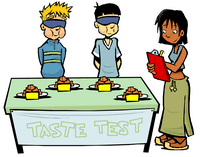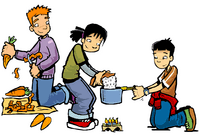
COOKING

 | COOKING |
 |
 This page was developed with the aim of teaching scouts the skills required to achieve the South African Fires and Cooking scoutcraft badge and the Cook Interest Badge. It is also helpful to those just wanting to learn a few new trick or gain some receipts. So good luck and happy cooking!
This page was developed with the aim of teaching scouts the skills required to achieve the South African Fires and Cooking scoutcraft badge and the Cook Interest Badge. It is also helpful to those just wanting to learn a few new trick or gain some receipts. So good luck and happy cooking!

1: Carry out an experiment to determine the burning properties of a least three different types of wood for cooking fires, and discuss their characteristics and the purposes for which each should be used.
What more can be said than go out and try it yourself! But here are some tips to get you started. Soft wood burns faster than hard woods, but hard woods provide better coals. A stick is still wet if it does not make a cracking sound when broken. Never take dead branches off a tree, it can still be wet. Damp logs can be dried by putting them next to the fire. In South Africa thornwood is great for lasting coals or there�s Black walter, which is not as good, but freely available any where.
Never use any wood that contains white sap in the leafs or branches!!!!!
2: Demonstrate three different types of cooking fire in use, and explain the advantages of each. Know the dangers of veld fires and demonstrate how to take saftey precautions when lighting, using and extinguishing fires in the open. Demonstrate methods of extinguishing flames.
Check out requirement 6f of Camping as well as the Fire Places.3: Make a camp fireplace in the open that is suited to the natural surrounding, or make a conservation stove. Make a fire in it, and cook the following for at least four people:
(A) Porridge
(B) Hunter's stew
4: Discuss the importance of dietically sound menus. Draw up a menu for a three-course breakfast, lunch and supper. Draw up the food quantities and cost these at a local store.
Again you need to go out and do this yourself. Try to picture the normal things you eat for breakfast, lunch and supper and use them in the menu or you could make a theme out of it. How about cooking only Greek or Russian food or only dishes that start with the letter L, that would be a challenge. An example of breakfast would be: An Lightly toasted muffin or sliced fruit with yoghart, then a bowl of porridge or cereal and finally bacon, eggs, toast, fried tomatoes and onions. Now that you have decided on the menu you need to workout the quantities of each item required. Example if its for 2 people you will need say: 2 muffins bought at a store, 10g of marg, 2 sliced grapefruits or watermelon, etc, 150g of cereal, 200ml milk, 50g sugar, 2 eggs, 200g bacon, 5ml oil or 30g marg, 2 pieces bread, 2 tomatoes, 1 onion. Now armed with a quantities list, you just to go out and price the items to find out your costs.5: Demonstrate the following:
(A) The setting of a table in camp or indoors for a lunch or a supper.
(B) How to prevent accidents in the kitchen at camp and indoors.
(C) The use of weights and measure in the kitchen.
6: Make yourself a damper or a twist.
A twist is just dough wrapped around a stick that is cooked over a fire. Take the bark off a green stick about 2 cm thick and wrap the dough around it. You can either make the dough yourself, by adding water to flour and mixing, remember you can always add more water, but you may run out of flour or for quick use on a Friday night buy dough from your local store. Don�t make the dough too thick or the inside will not cook. Don't cook over flames and keep rotating it till browned. Once cooked it�s great with marg, jam or syrup.7: After each cooking, properly dispose of rubbish, clean utensils, and leave a safe, clean cooking area and fireplace.
All I can say here is what BP said: All that should be left behind is your thanks.If you have any other question relating to the topic or any ideas to share please fell free to contact the webmaster at: [email protected]